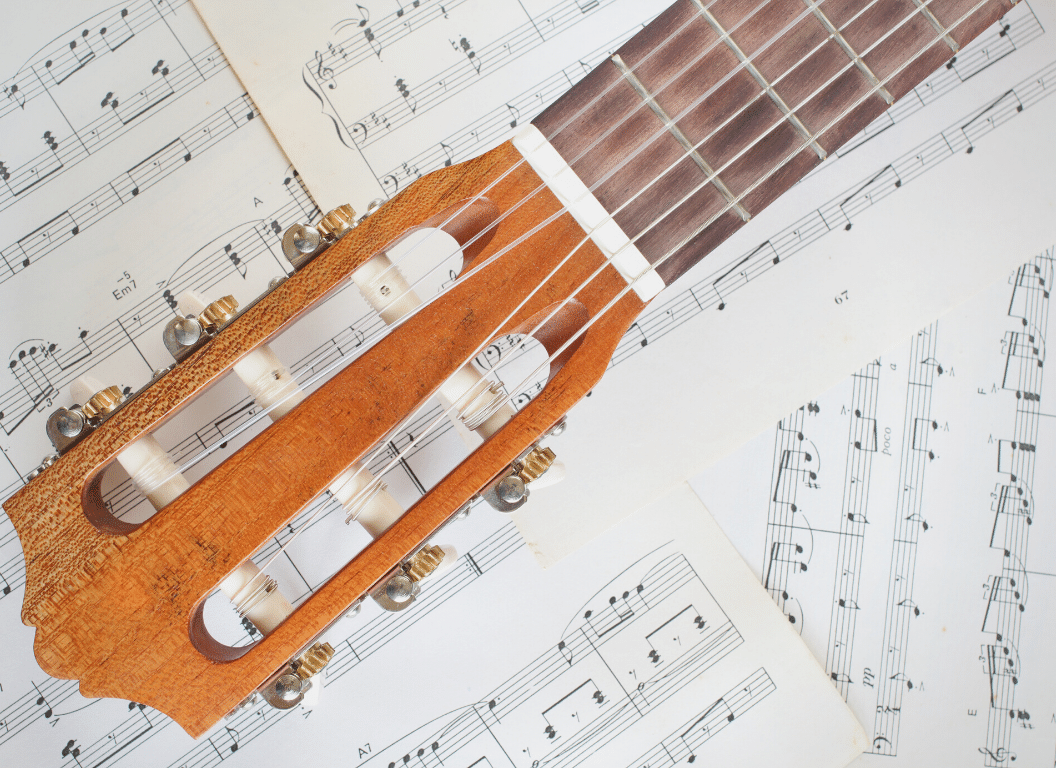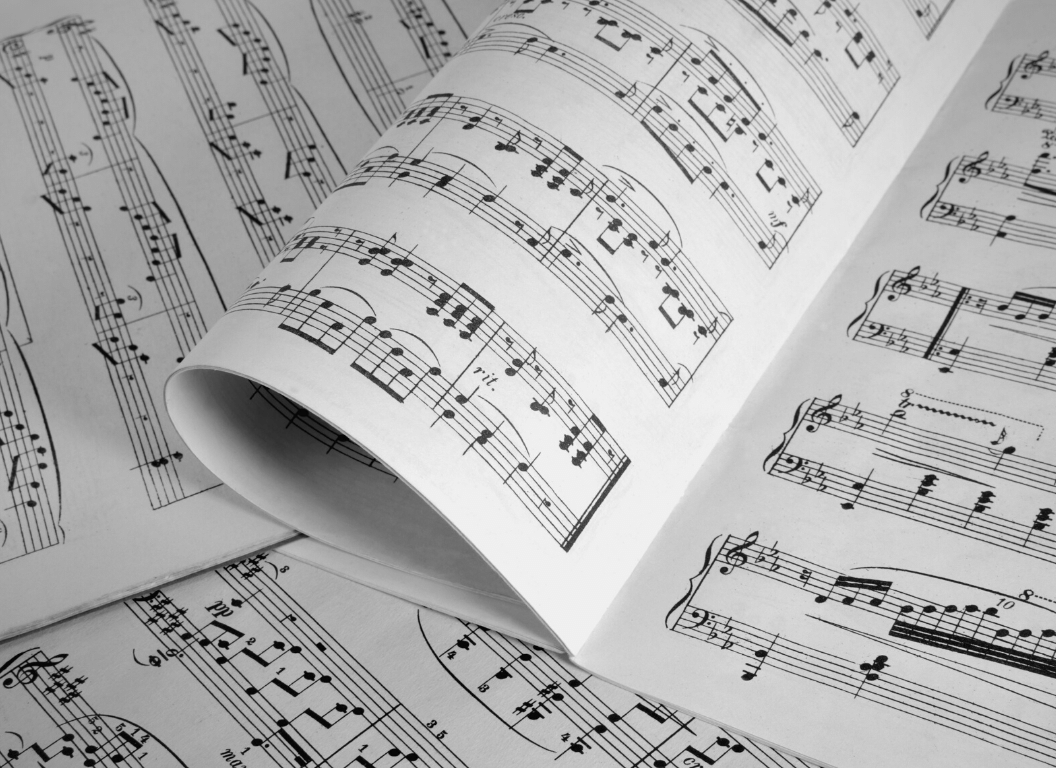Aspiring guitarists often find themselves facing a steep learning curve when first encountering guitar scale tabs.
Despite their complexity, mastering these graphical representations of musical scales is crucial for any serious musician.
This practice not only broadens their playing repertoire but also lays the foundation for improvisation and composition.
However, the task of deciphering these tabs is not as daunting as it may initially seem.
With a comprehensive understanding of their schematic arrangement and the notation system, one can quickly gain proficiency.
Our objective here is to unravel the mystery behind scale tabs, breaking them down into simple, manageable components for easier comprehension.
Table of Contents
- Guitar Scales Tabs | The Ultimate Guide On How To Read & Understand Them
- Understanding the Basics of Guitar Scales Tabs
- What do the Numbers On The Guitar Scale Tabs Represent?
- How to Read Horizontal and Vertical Lines On The Tabs
- Understanding the Numeral Representation
- What do Various Symbols Mean in Scale Tabs?
- Reading and Interpreting Guitar Scales Tabs
- Common Mistakes to Avoid When Decoding Scale Tabs
- 4 Tips to Get Better at Reading Guitar Scales Tabs
- The Bottom Line
Guitar Scales Tabs | The Ultimate Guide On How To Read & Understand Them
Reading and understanding guitar scales tabs involve recognizing the horizontal lines as strings and the numbers as frets. The ultimate guide includes learning to interpret the various symbols, like slide, bend, hammer on, pull off, and vibrato, which denote different playing techniques. Mastery of guitar scales tabs allows musicians to understand and replicate music as it is written or to compose their own.
Expanding on this subject, we will delve deeper into the specific symbols that can appear On The guitar scales tabs, with an emphasis on how to interpret and apply them.
We are going to identify how different symbols translate into various guitar techniques, helping you understand the nuances of guitar playing.
Topics such as the application of scales in musical composition and improvisation will also be addressed.
This comprehensive guide will provide practical knowledge for every level of guitar player, from novice to professional, reinforcing foundational skills and introducing advanced concepts.
This knowledge can be instrumental in enhancing musical interpretation, improvisation, and composing abilities.
Stay tuned as we explore these important facets of guitar scales tabs.
Understanding the Basics of Guitar Scales Tabs
Are you keen on improving your guitar playing skill and expanding your musical knowledge?
If so, learning to read guitar scales tabs is an essential skill to have.
Guitar scales tabs are a valuable learning tool which provides a visual representation of the notes that make up a scale On The guitar fretboard.
They serve as a map for the fingers, illustrating where to place your fingers On The guitar fretboard in order to play a particular scale.
This video is an effective way to introduce the topic of scale tabs, clarifying this abstract concept into a practical context.
By watching, you’ll gain a more comprehensive intro to the relationship between notes, scales, and the guitar fretboard.
What Are Guitar Scales Tabs?
A tab, or tablature, is a type of musical notation specifically designed for stringed instruments like the guitar.
Unlike standard musical notation, which represents the pitch and rhythm of a piece of music, guitar tabs show the exact finger positions On The fretboard to play a specific note or chord.
“Guitar tabs show the exact finger positions On The fretboard to play a specific note or chord”
Supporting this statement, one could say that tabs transform the abstract concept of music into a physical process.
They depict the mechanics behind each note, making it easier for the player to understand.
How are Scales Represented in Tabs?
When it comes to scales, each note of the scale is represented by a number.
This number corresponds to the specific fret On The guitar fretboard.
If a number is written without any adjacent numbers, this means you should play that one note on its own.
When numbers appear together horizontally, it indicates you should play these notes simultaneously, creating a chord.
Importance of Mastering Guitar Scales Tabs
Mastering guitar scales tabs is a gateway to musical fluency.
Understanding the mechanics of the fretboard and the scales that run across it enhances your musical toolbox, making you a more versatile player.
By internalizing the layout of scales On The fretboard, you can navigate it with more ease and precision.
“Understanding the mechanics of the fretboard and the scales that run across it enhances your musical toolbox, making you a more versatile player.”
Once you’ve understood and memorized positions for different scales, it will become second nature.
Your fingers will instinctively know where to go On The fretboard when you’re playing a particular piece of music.
Role of Guitar Scales Tabs in Learning
Learning to read and understand guitar scales tabs is a crucial part of getting better at playing the guitar.
They help clarify where exactly your fingers need to be to produce the correct sound.
Moreover, they allow you to visually understand the structure of a particular scale.
Finally, understanding tabs opens the door to learning many other music aspects like chords, licks, and solos.
Armed with guitar scales tabs, any aspiring guitarist can go from novice to proficient in no time.
What do the Numbers On The Guitar Scale Tabs Represent?
The numbers On The Guitar scale tabs play a pivotal role in understanding how to properly play the notes On The instrument.
These numbers directly correspond to the fret number On The guitar where the note needs to be played.
Typically, these are written across six horizontal lines which each represent a string On The guitar, from the bottom E string to the top E string.
For instance, if you see the number ‘3’ On The second line from the top, it indicates that you should play the third fret On The B string.
The tabs are read from left to right, indicating the sequence and timing of the notes played.
Numbers on a guitar scale tab represent the specific frets On The guitar where notes are to be played.
Knowing this, you can easily play a tune or scale by simply following the numbers On The tab, without needing to read traditional music notation.
Remember, zero on a tab represents an open string, which means that the string should be played without pressing any fret.
So, if you see a ‘0’ On The top line, you should play the open high E string.
It is important to note that tabs do not typically provide information about the rhythm or timing of the notes.
They simply tell you where and when to play the notes.
It’s crucial to know the piece of music or to have an audio reference to understand the timing.
How to Read Horizontal and Vertical Lines On The Tabs
The horizontal and vertical lines On The Guitar scale tabs have specific meanings that help in understanding how to properly interpret the music On The guitar.
There are usually six horizontal lines which each represent a string On The guitar.
Each of these lines corresponds to a string On The guitar, with the top line representing the high E string and the bottom line representing the low E string.
The vertical lines are used to divide the tab into measures.
Each vertical line represents a beat or a particular time in the song.
The horizontal lines on a guitar tab represent the six strings On The guitar, while the vertical lines divide the music into discrete beats.
This is important to understand to get the timing of the song right.
Remember that timing is not usually specified in tabs, hence you will need to know the song well.
The order in which you read a guitar tab is from left to right, just like reading a book.
If you face a stack of numbers, called a chord, play all these numbers (frets) at once.
Finally, reminders that spaces between numbers may constantly change as they don’t necessarily represent the length of each note but the speed of a particular melody section.
You need to rely heavily on your listening skills to keep up with the rhythm.
Now that you understand the significance of these lines and numbers, you will be better equipped to read and play from guitar scale tabs.
Understanding the Numeral Representation
One of the most crucial aspects in beginning the journey to understand guitar scale tabs is deciphering the numbers they present.
The rows of numbers that you will see spread across the lines are an integral part of the tab and each of them represents a particular fret On The guitar’s neck.
These numbers are employed to indicate exactly where your fingers should be placed On The fretboard while playing.
The order in which these numbers appear in the guitar scales tabs is also important.
The sequence in which the figures are displayed represents the flow of notes to be played, typically from left to right.
Importance of Zero
An often misunderstood or overlooked number in these scale tabs is the number ‘0’.
The digit ‘0’ denotes an open string which implies that it should be played without fretting it.
It adds a different tonal variation to the melody and varying them with fretted notes can result in beautiful music.
The correct interpretation and timely use of the ‘0’ in guitar tabs is essential for effective scale progression.
Multiple Numbers on a Vertical Line
There will be times when you’ll notice multiple numbers stacked upon each other On The same vertical line in the scale tab.
These are used to depict chords which involve playing multiple notes simultaneously.
This is an example where the flow that is normally considered left to right in scale tabs gets modified to top to bottom for those particular set of notes.
Differentiating between single notes and chords, and playing them accordingly, adds a new dimension to your guitar playing skills.
Differentiating between single notes and chords, and playing them accordingly, adds a new dimension to your guitar playing skills.
This distinction might seem trivial initially, but understanding these nuances is the key to mastering guitar scale tabs.
If you pay attention to understanding the role of these numbers and what they denote On The guitar’s fretboard, it will unlock a whole new repertoire of songs and scales for you to play.
Understanding this notation allows you to take any tab from anywhere and start playing.
A lot of these numeral denotations are depicted with examples and played in this embedded video for a better comprehension.
By spending time watching it, you will understand the application and importance of these numbers not just in theory, but also in a practical sense.
What do Various Symbols Mean in Scale Tabs?
As you delve deeper into guitar scale tabs, it’s inevitable that you’ll encounter various symbols.
These include but are not limited to slide, bend, hammer on, pull off, and vibrato.
Understanding the Slide
First on our list is the slide.
The slide is a technique in which a note is played and then the finger is ‘slid’ to another fret without picking the string again.
It’s represented on a tab with the sign ‘/’ or ” between two notes.
This symbol informs the guitarist to play the first note and then move up or down to the second note, while allowing the note to ring.
The slide is a guitar technique where a note is played and then the finger is ‘slid’ to another fret without picking the string again.
By mastering the slide, a guitarist is able to create smooth transitions from one note to another, generating an effect that is markedly different from what is achieved by simply plucking each note individually.
This technique can vastly enhance the expressiveness of your guitar playing.
Deciphering the Bend
Next, we have the bend.
A bend is when the string is plucked and then bent or stretched to higher note.
In tablatures, this technique is denoted by a curved arrow leaning upwards with the target pitch written above it.
Just like the slide method, this allows you to move from one note to another without having to pluck the string again.
Mastering the bend technique can allow you to emulate the human voice with your guitar, creating a wailing or crying sound that can add dramatic effect to your solos.
Combining this technique with others, you can create a myriad of sounds and textures, helping you to explore the full potential of your guitar.
Hammer On and Pull Off
Now let’s touch upon the hammer on and pull off techniques.
A hammer on is when a string is plucked and then another note is sounded by forcefully pressing a finger onto a different fret.
It’s symbolized On The tab with an arc or a ‘h’ between two numbers.
The pull off, On The other hand, is when a string is plucked, another note is fretted, and then that finger is ‘pulled’ off to sound a note on an open string or a lower fret.
It’s shown on tab with a ‘p’ notation.
These techniques are great for creating fast runs and smooth phrases when playing solos.
Indeed, getting comfortable with hammer ons and pull offs can allow you to smoothly transition between notes without the need for multiple plucks.
Mastering the Vibrato
Lastly, we have the vibrato.
This is when a note is struck and then rapidly and repeatedly bent up and down at a consistent pace.
On a tab, vibrato is depicted with a wavy horizontal line above the fret number.
Vibratos can add expression to your playing and create a unique sound that can truly make a piece your own.
Their application in solos can provide an emotional edge, adding richness to the overall sound of your guitar playing.
In essence, mastering and understanding the various symbols used in guitar scale tabs like slide, bend, hammer on, pull off, and vibrato can take your guitar playing ability to the next level and allow you to create rich, expressive pieces.
Reading and Interpreting Guitar Scales Tabs
The interpretation of guitar scale tabs starts with understanding what the lines and numbers On The tabs represent.
Each horizontal line on a tab represents a string On The guitar, with the top line referring to the high E string, and the bottom line referring to the low E string.
Meanwhile, the numbers placed on these lines represent the fret that should be played On The respective string.
Reading Guitar Scale Tabs
In a tab sheet, numbers are arranged left to right, similar to how you would read words on a page.
Each number would indicate the fret you’d need to press.
The order to play them follows from left to right.
It’s important to remember that if numbers are stacked vertically on top of each other, they should be played simultaneously.
Paying attention to this arrangement is crucial in accurately interpreting scale tabs.
Each number would indicate the fret you’d need to press.
The order to play them follows from left to right.
This fundamental aspect of reading tabs enables you to follow the musical score accurately.
Knowing exactly which notes to play and when to play them forms the backbone of your performance.
Interpreting Symbols in Guitar Scale Tabs
Beyond numbers, tabs also feature various symbols which represent different playing techniques.
These symbols like Slide, Bend, Hammer-On, Pull-Off, and Vibrato, among others provide information on how to play a particular note or series of notes.
For instance, a ‘h’ symbol indicates a hammer-on, where the guitarist plays two notes but plucks the string only once.
The embedded video provides a visual guide on how to interpret and apply these symbols.
This hands-on approach might help in solidifying your understanding and improving your skills greatly.
Practice to Improve
Learning to read guitar scale tabs is a process that involves practice.
Starting slow with simple tabs is recommended, gradually increasing complexity as understanding and skill improve.
Challenging yourself with complex tabs can help accelerate your learning process.
Ultimately, the goal is to be able to intuitively understand and react to the scale tabs without having to think too hard about them.
Starting slow with simple tabs is recommended, gradually increasing complexity as understanding and skill improve.
Gaining an understanding of guitar scale tabs gradually and increasing complexity at your own pace is crucial for successful learning.
The process might seem challenging at first, but consistent effort and practice result in noticeable improvement.
Common Mistakes to Avoid When Decoding Scale Tabs
When learning how to read and interpret guitar scale tabs, it’s inevitable that you will make mistakes.
However, understanding these common errors can speed up your learning process by helping you avoid these pitfalls.
Misreading Tablature Numbers
One of the most common mistakes is misreading the numbers On The tablature.
This is often due to not understanding that the numbers represent frets On The guitar neck, and not your fingers.
For example, a 0 indicates an open string, while a 1 would indicate the first fret, not the first finger.
Ignoring Tab Symbols
Another common mistake is ignoring or misunderstanding the various symbols used in guitar scale tabs.
These symbols can represent a variety of techniques, like sliding, bending, hammering on, or pulling off.
Skimming over these marks or misinterpreting them can drastically change the sound of the music.
Proper interpretation of symbols in guitar scale tabs is crucial to producing correct sound.
As detailed earlier, each symbol gives a specific instruction related to how a note should be played.
Providing additional information like when to bend a note, shift positions, or apply vibrato, they can significantly impact the overall feel and tone of the piece.
Trying to Play Too Quickly
Lastly, many beginners try to play the tabs too quickly and without sufficient practice.
The point of guitar scale tabs is to provide directions regarding the exact notes and techniques to reproduce a particular piece of music.
Therefore, rushing through these instructions without fully digesting them can lead to sloppy playing and misunderstanding of the musical piece.
Remember, it’s always recommended to take a flexible and slow approach while learning to read tabs.
The ultimate aim is to understand the music you are playing so you can eventually play it fluently and expressively.
Rushing through guitar scale tabs without fully understanding them can lead to sloppy playing.
It’s paramount that, while learning to decode and play tabs, beginners should focus on understanding each and every symbol and number.
Once the understanding grows, speed and precision can be gradually added to the mix.
In sum, avoiding these common mistakes can significantly enhance your ability to decode and play guitar scale tabs effectively and accurately.
4 Tips to Get Better at Reading Guitar Scales Tabs
Mastering the art of reading guitar scale tabs swiftly can seem challenging, but with the right techniques, it becomes quite manageable.
Speed and fluency in tab reading are not just about understanding numbers and symbols; it’s also about knowing how to approach the scales and leverage your previous knowledge.
Think in Patterns
One of the first tricks to apply is thinking in patterns.
Guitar scale tabs are essentially diagrams of finger placement patterns On The guitar neck.
This way, instead of simply memorizing each individual note, you can grasp a whole scale as a broader, interlinked pattern.
It greatly reduces the cognitive load and enhances the speed of comprehension.
“Guitar scale tabs are essentially diagrams of finger placement patterns On The guitar neck.”
Remember, our brains are innately wired to recognize and remember patterns.
Leveraging this ability can tremendously boost your tab reading speed.
Visualize the Sounds
Another significant trick is to visualize the sounds as you read the tabs.
Try to imagine how the strings’ vibrations would sound when your fingers press down On The specified frets.
This visualization technique attaches an audio element to the visual data, making it easier and faster for your brain to process.
“Try to imagine how the strings’ vibrations would sound when your fingers press down On The specified frets.”
Connecting the visual data from the tabs with auditory anticipation in your mind can help streamline the learning process.
Practice Regularly
Like any other skill, regular and deliberate practice plays a huge role in enhancing your tab reading speed.
You do not have to devote hours each day; consistent, focused sessions are more important.
Start with simpler tabs and gradually move towards the complex ones.
‘Regular and deliberate practice plays a huge role in enhancing your tab reading speed.’
Every bit of practice trains your brain to better recognize patterns and anticipate auditory outcomes, which will eventually increase your tab reading speed.
Watch and Learn
Combining your self-study with some expert lessons can also be very beneficial.
Watching others decipher and perform complex tabs can provide valuable insights that you can apply in your own practice.
From this video, you might gather some effective techniques on how to decipher advanced symbols in tabs.
Plus, it offers a hands-on demonstration of interpreting and implementing the tabs, which might help reinforce your understanding.
In conclusion, mastering guitar scale tabs quickly is a matter of smart strategies and consistent practice.
Don’t shy away from exploring new techniques and learning from others.
Remember, every guitarist’s journey is unique.
Find what works best for you and stick to it.
The Bottom Line
Mastering the ability to read and interpret guitar scale tabs is a crucial skill for any guitarist.
Through understanding the significance of numbers, horizontal and vertical lines, and various symbols such as slide, bend, hammer on, pull off, and vibrato, players can navigate complex scales effortlessly.
Avoiding common mistakes and following step-by-step guidelines will aid in this process.
The right tips and tricks will enable rapid mastery, which will ultimately have a positive impact on improvisation and composition.
To overcome challenges and apply this knowledge, practice and consistency are key.
Therefore, the journey to understanding guitar scale tabs can indeed be intricate and requires dedication, but the musical payoff is immeasurable and distinct.
In love with guitars, and gear; expert in all things music! Been writing about guitars for about 5 years and counting. Born in the ’90s. Alma Mater: University of Havana. Always curious, trying to understand the world. #TeamFender




